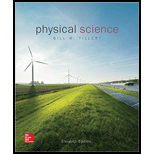
Physical Science - With Lab Manual
11th Edition
ISBN: 9781260021417
Author: Tillery
Publisher: MCG
expand_more
expand_more
format_list_bulleted
Concept explainers
Question
Chapter 10, Problem 32AC
To determine
For the given chemical equation,
a. the total mass of the gaseous reactants is less than the total mass of the liquid product.
b. the total number of molecules in the reactants is equal to the total number of molecules in the products.
c. one volume of oxygen combines with two volumes of hydrogen to produce two volumes of water.
d. All of the above are correct.
Expert Solution & Answer
Want to see the full answer?
Check out a sample textbook solution
Students have asked these similar questions
A 60.0 g of CaC2 reacts with water to produce C2H2 and 81.2 g of Ca(OH)2. The reaction between these two substances are chemically written as:
_______ CaC2 + ______ H2O → _____ C2H2 + _______ Ca(OH)2
Balance the chemical equation.
Calculate the molar mass of CaC2 and Ca(OH)2?
What is the theoretical yield of Ca(OH)2? What is the percent yield of this reaction if the actual yield of Ca(OH)2 exceeds 2.1 g ?
4. How many milliliters of 0.200 M NH2OH are needed to react with 12.0 mL of 0.550 M FeCl3?
FeCl3 + 3NH4OH → Fe(OH)3 + 3NH4Cl
A.Use the bond energies to determine whether the following reaction is exothermic or endothermic and what is the amount of energy released or absorbed?
H-O – O-H + H-O – O-H ---> O=O + H – O –H + H –O – H, hydrogen peroxide reacts to form oxygen gas and water.
B. What are theBonds to Break, Bonds to Form?
Chapter 10 Solutions
Physical Science - With Lab Manual
Ch. 10 - Prob. 1ACCh. 10 - Prob. 2ACCh. 10 - Prob. 3ACCh. 10 - Prob. 4ACCh. 10 - Prob. 5ACCh. 10 - Prob. 6ACCh. 10 - Prob. 7ACCh. 10 - Prob. 8ACCh. 10 - Prob. 9ACCh. 10 - Prob. 10AC
Ch. 10 - Prob. 11ACCh. 10 - Prob. 12ACCh. 10 - Prob. 13ACCh. 10 - Prob. 14ACCh. 10 - Prob. 15ACCh. 10 - Prob. 16ACCh. 10 - Prob. 17ACCh. 10 - Prob. 18ACCh. 10 - Prob. 19ACCh. 10 - Prob. 20ACCh. 10 - Prob. 21ACCh. 10 - Prob. 22ACCh. 10 - Prob. 23ACCh. 10 - Prob. 24ACCh. 10 - Prob. 25ACCh. 10 - Prob. 26ACCh. 10 - Prob. 27ACCh. 10 - Prob. 28ACCh. 10 - Prob. 29ACCh. 10 - Prob. 30ACCh. 10 - Prob. 31ACCh. 10 - Prob. 32ACCh. 10 - Prob. 33ACCh. 10 - Prob. 34ACCh. 10 - Prob. 35ACCh. 10 - Prob. 36ACCh. 10 - Prob. 37ACCh. 10 - Prob. 38ACCh. 10 - Prob. 39ACCh. 10 - Prob. 40ACCh. 10 - Prob. 41ACCh. 10 - Prob. 43ACCh. 10 - Prob. 44ACCh. 10 - Prob. 45ACCh. 10 - Prob. 46ACCh. 10 - Prob. 47ACCh. 10 - Prob. 48ACCh. 10 - Prob. 49ACCh. 10 - Prob. 1QFTCh. 10 - Prob. 2QFTCh. 10 - Prob. 3QFTCh. 10 - Prob. 4QFTCh. 10 - Prob. 5QFTCh. 10 - Prob. 6QFTCh. 10 - Prob. 7QFTCh. 10 - Prob. 8QFTCh. 10 - Prob. 9QFTCh. 10 - Prob. 10QFTCh. 10 - Prob. 11QFTCh. 10 - Prob. 12QFTCh. 10 - Prob. 1FFACh. 10 - Prob. 2FFACh. 10 - Prob. 3FFACh. 10 - Prob. 4FFACh. 10 - Prob. 1IICh. 10 - Prob. 1PEBCh. 10 - Prob. 2PEBCh. 10 - Prob. 3PEBCh. 10 - Prob. 4PEBCh. 10 - Prob. 5PEBCh. 10 - Prob. 6PEBCh. 10 - Prob. 7PEBCh. 10 - Prob. 8PEBCh. 10 - Prob. 9PEBCh. 10 -
10. Iron(III) oxide, or hematite, is one mineral...
Knowledge Booster
Learn more about
Need a deep-dive on the concept behind this application? Look no further. Learn more about this topic, physics and related others by exploring similar questions and additional content below.Similar questions
- 1. Explain the reasons for energetic materials safety testing, and in general, how we perform the testsarrow_forward2. Which of the following is an example of bottom-up approach for the preparation of nanomaterials? a) Etchingb) ion beam c) Lithographyd) Erosion e) none of themarrow_forward4. How must nuclear waste that is considered high-level waste be stored? A.sealed away from living things for thousands of years B.buried in a special landfill for short periods of time C.cooled in water for a few days after being used up D.kept warm in heated water for one to two centuriesarrow_forward
- A number of reactions that take place on the surfaces of catalysts are zeroth order in the reactant. One example is the decomposition of ammonia on hot tungsten. In an experiment, the partial pressure of ammonia decreased from 21 kPa to 10 kPa in 770 s. (i) What is the rate constant for the zeroth-order reaction? (ii) How long will it take for all the ammonia to be consumed?arrow_forward4. Explain the difference between attractive and repulsive forca.arrow_forward
arrow_back_ios
arrow_forward_ios
Recommended textbooks for you
 An Introduction to Physical SciencePhysicsISBN:9781305079137Author:James Shipman, Jerry D. Wilson, Charles A. Higgins, Omar TorresPublisher:Cengage Learning
An Introduction to Physical SciencePhysicsISBN:9781305079137Author:James Shipman, Jerry D. Wilson, Charles A. Higgins, Omar TorresPublisher:Cengage Learning

An Introduction to Physical Science
Physics
ISBN:9781305079137
Author:James Shipman, Jerry D. Wilson, Charles A. Higgins, Omar Torres
Publisher:Cengage Learning